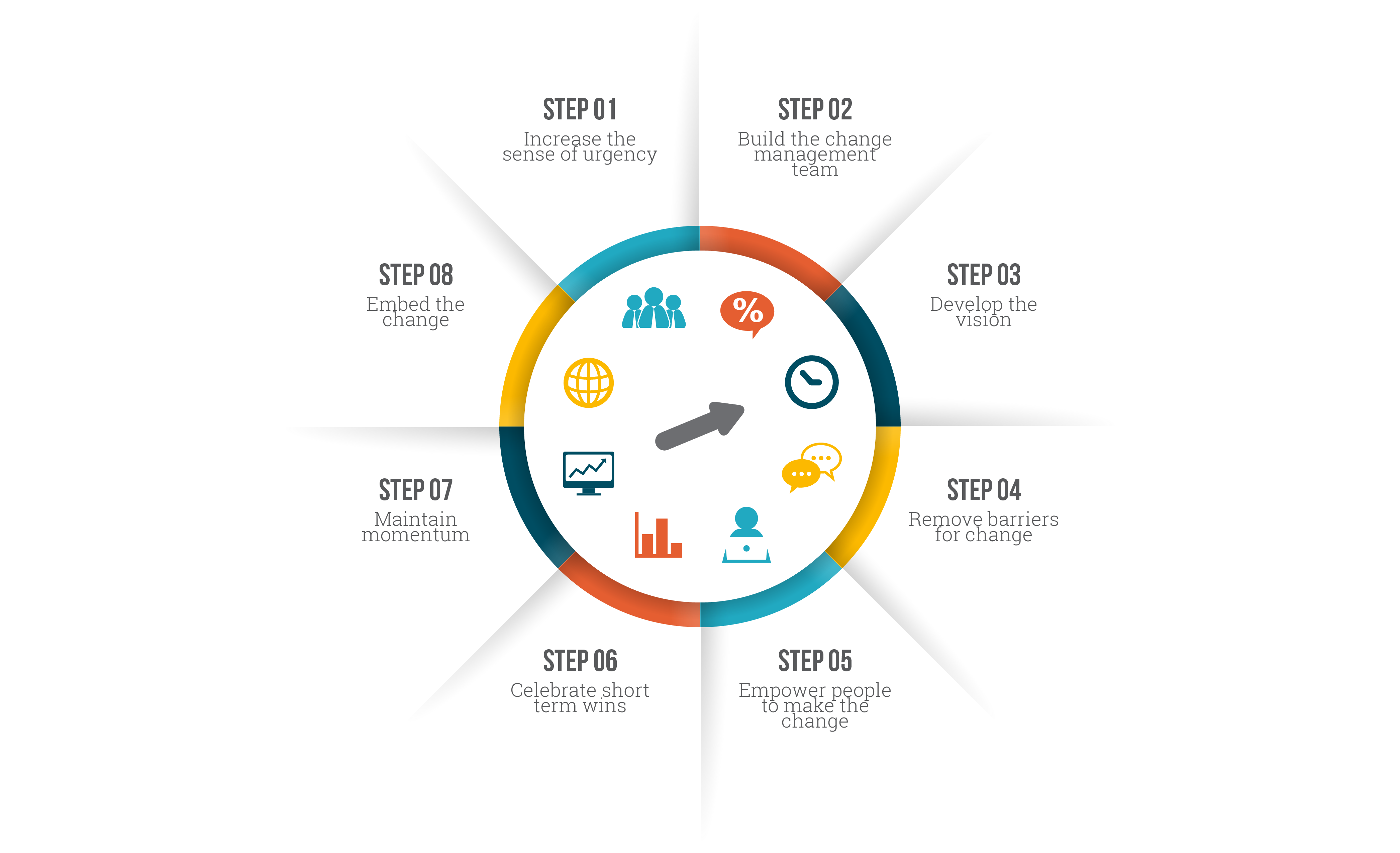How often have you heard that the users are to blame for a software system not working as it is designed? How many software projects are forever stuck in a proof-of-concept, unable to find traction across the whole organisation? The answer might lie in how change management is being approached on the project.
Software technology projects are known for having a high risk of failure. There are often several reasons for this:
- The software is not a good fit for the business requirement.
- The business is unclear on the requirements for a software solution.
- The implementation is incomplete, rushed or poorly executed.
- The project team has compromised the design, configuration, or testing.
- Inadequate time or budget is often linked to the initial complexity being underestimated.
- Poor quality assurance at critical milestones.
- A lack of proper change management.
When a project fails, there are usually many fingers pointed and blame-shifting as people try to rationalise the root causes. Lessons learned are recorded. These lessons inevitably categorise “change management” as the catch-all for all those intangible symptoms of failure that cannot be attributed to anything else. After all, when all else fails, blame the users!
This article is the first in a series of articles on change management in software projects. We will draw on our experience implementing control of work and safety management systems in industry. The topics that will be covered in this series include:
- What is change management and why change management is so important
- Change management techniques
- Organisational maturity
- Embedding and sustaining the change
What is change management?
Installing the best software in the world is not enough to ensure that you will reap the rewards. Project success often lies not in the software itself but in the way it was implemented. The good news is that if you use a good methodology (incorporating change management), you are likely to get predictable and consistently excellent results, even if the software solution does not at first seem like a perfect fit.
The PMI defines change management as “an organised, systematic application of the knowledge, tools, and resources of change that provides organisations with a key process to achieve their business strategy”.
At a more practical level, change management enables the organisation to:
- Align to a shared vision of a better future state.
- Help people make the journey through the change.
- Build trust and confidence in the teams involved in the change.
- Address individual concerns along the way that could derail the project.
- Embed new ways of working to reap the benefits of the change.
Your role in change management
Effective change is the responsibility of all stakeholders on a software project, whether you are part of a project team, a project sponsor, a consultant, or an end user.
Before “managing” change in others, taking personal responsibility for your own leadership role is essential. This includes:
- Make sure you understand why the need for the change.
- Recognising your impact on the change process.
- Supporting your team through the transition.
- Being open to feedback and learning from mistakes.
- Remaining positive and acknowledging that your attitude will affect others.
Change management is an essential skill for any project manager or consultant. Owing to the wide range of change projects, change management as a discipline has evolved into an entire industry with professionals certified in specialised roles. It is recommended that all members of project teams ensure they understand and appreciate the need for change management at project kick-off.
Change management and the organisation
Change management seeks to bring about wide-ranging organisational change. But organisations are made up of normal people. So, while it might be relatively easy to change the behaviours of a few individuals closely associated with the project, it is also necessary to plan for the future impact on the broader organisation. Software projects that successfully work as a proof of concept can fail spectacularly during a roll-out if sustained change management is neglected.
Organisational change management must be an intentional process that is incorporated in the implementation methodology of a project. It needs to be managed diligently as any other aspect of the project. How many project meetings include change management as a high priority item on the agenda?
A holistic approach
Fundamentally, a change management process attempts to understand the reasons why people might resist change and develop effective strategies to overcome these to ensure a successful outcome.
There are many theoretical change management models, some suitable for wide-ranging strategic business initiatives, others for small once-off projects, and others for deep rooted cultural transformation. Many organisations have incorporated several best change management practices into their project methodology. To avoid reinventing the wheel, a project team member must first understand and align to the organisation’s existing change management approach.
We suggest having a toolkit of techniques, drawn from the best of several theoretical models. These tools can be used in developing the most appropriate change management strategies for a specific project. I have selected some of the more commonly used models below. A Google search will quickly reveal more details and several others.
Kotter’s Theory of Change Management
Directed at change management professionals, John Kotter (Harvard Business School) developed a practical technique for change management that involves the following steps:
- Create a sense of urgency.
- Build the change team.
- Develop and communicate the strategic vision.
- Remove barriers to change.
- Focus and celebrate on short-term wins.
- Maintain momentum.
- Institute change (embed the change).
Kubler-Ross Change Curve
Employees experiencing change may undergo emotional reactions, depending on their personal impact. The Kubler-Ross Change Curve™ acknowledges that the response to change usually follows the following process:
- Shock and denial.
- Anger.
- Bargaining.
- Depression.
- Acceptance.
The Bridges Transition Model
A simpler, alternative view of this transition is the Bridges transition model, which narrows down the emotional reaction to change into just three phases:
- Ending and letting go.
- The neutral zone (where performance has dropped off).
- The new beginning (where performance has been enhanced in the new environment).
Satir Change Model
The Satir change model describes the same transition as follows:
- Late status quo
- Resistance
- Chaos
- Integration
- New status quo
While change management is often focused on the “soft aspects,” i.e., people’s feelings, attitudes, and behaviours, it is also essential to consider the tangible aspects. In the article “The Hard Side of Change Management” (Harold L. Sirkin, 2022), the authors remind us that measuring the impact of change using traditional business metrics is also important. What you are unable to measure cannot be properly managed. The business value of a software solution is usually measured in terms of improved efficiency, reduced costs, streamlined/automated processes etc. All these benefits should be linked to your business KPIs and monitored before, during and after the change.
Communicating the WHY
Arguably the most critical aspect of change management is explaining why the change is necessary to the business. Without a shared vision and strategy, initiatives requiring behavioural change are likely to fail.
Communicating change must link the solution’s benefits to the business strategy in a way that motivates people and is compelling to the stakeholders. Sometimes there will be an overarching strategic theme such as “modernisation” or ”digital transformation” that provides context for the change as part of a broader strategy.
A consistent “why” message must be reinforced at every opportunity and all levels in the organisation. Look for consistency in all project communications, including progress reports, meetings, and training sessions. Look for communication opportunities such as newsletters, posters, webinars and the use of multimedia tools and easy-to-understand infographics.
We have found that linking a software project to an overall transformation goal is a valuable way to explain to people that short-term pains will result in worthwhile longer-term gains. Focus on the benefits of the solution and the desired better future state. Describe the transformational journey and give people a roadmap showing the way forward. Ensure you address the WIIFM (what’s in it for me) aspect.
Strategic communication is most effective when concise and at the same time speaks also to individual aspirations. It takes time and effort to distil complex messages into simple, easy-to-understand concepts that resonate with teams – but this effort invested will certainly pay dividends.
Remember that each person is a communicator that has influence over many others. Communicating the reasons for the change is not just the job of the sponsor or senior executives. It is, in fact, incumbent on every member of a project team to be able to constantly amplify the reasons why the change is necessary.
When communicating change, it is usually helpful to consider Maurer’s three levels of Resistance and Change:
- I don’t get it (I don’t understand the purpose of the change or how to change)
- I don’t like it (I don’t believe that you or your solution will help me)
- I don’t like you (lack of trust and confidence)
Understanding and addressing these emotional responses proactively in your communication will go a long way in addressing individual resistance.
In the next article we will further unpack some change management approaches with some practical examples drawn from our experience with safety software implementations.
For more information
Adapt IT Manufacturing provides digital solutions that enhance safety performance and operational excellence to help industrial companies achieve more.
For more information on Adapt IT Manufacturing solutions, please contact the team.
More News and Articles
Q&A with IntelliPERMIT Consultant Lungelo Majozi
Explore the advantages of electronic permit to work (e-PTW) systems over paper methods, from faster investigations to specific hazard management. Learn how e-PTW enhances safety, prevents redundant isolations, and ensures accountability. Discover future trends like 3D modeling. IntelliPERMIT automates tasks, improves communication, and reduces costs, making workplaces safer and more efficient.
Powering Safety Innovations: An Exclusive Q&A with IntelliPERMIT Consultant Shirley Breytenbach
IntelliPERMIT transforms permit management with streamlined processes, competency-based approvals, and real-time visibility. Ensure regulatory compliance, enhance worker safety, and boost operational efficiency. The system offers seamless integration, empowering organisations to proactively mitigate safety risks.
Safety Software Implementation Success : An Exclusive Q&A with IntelliPERMIT Consultant Henry Boshoff
Unlock safety software success with IntelliPERMIT: Prioritise key features, secure user buy-in through change management, and foster collaboration. Set measurable goals, leverage incident data for proactive decisions, and ensure intuitive search capabilities. Streamline report generation and simplify scheduling and management of training, drills, toolbox talks, and audits. Overcome adoption challenges by addressing pain points and customizing the software. Enhance user adoption with automation and user-friendly interfaces. Evaluate safety software providers based on knowledge, experience, and adherence to standards—IntelliPERMIT excels. Easily integrate with existing systems through standard APIs. Opt for web-based software for accessibility and usability. IntelliPERMIT enhances safety practices and compliance.




